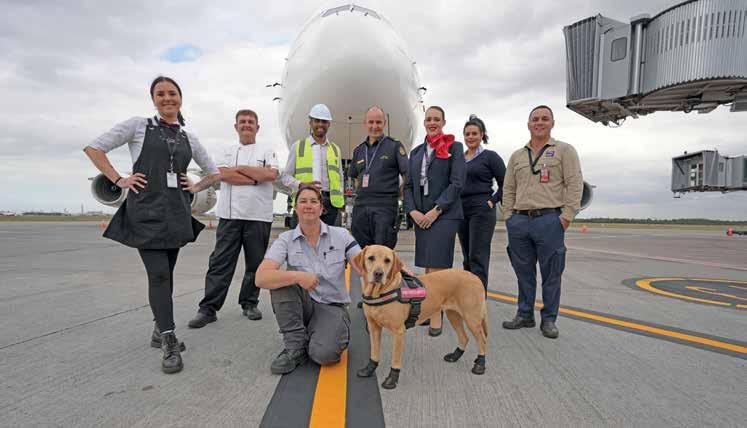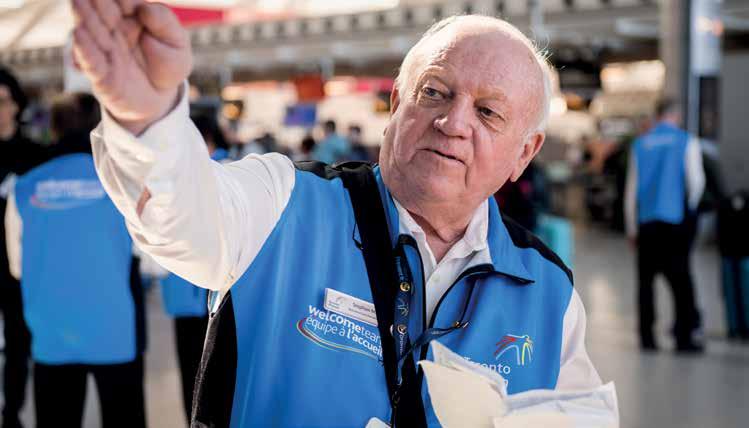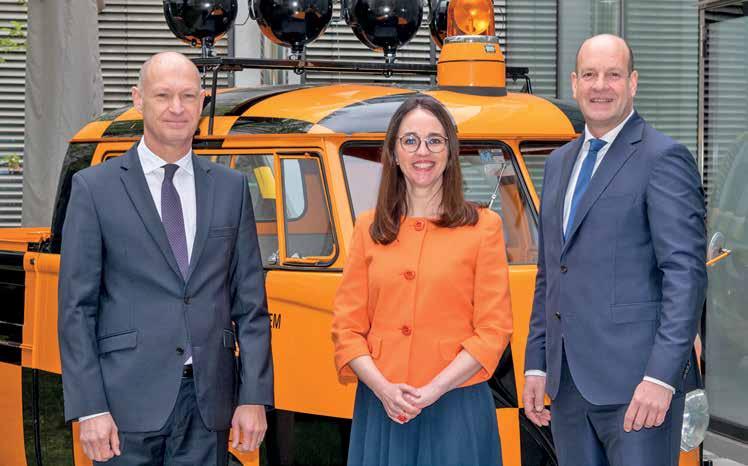
7 minute read
The numbers game
The global pandemic may be officially over with the World Health Organization officially declaring that COVID-19 is no longer a "global health emergency", but its impact on the aviation industry can still be felt today in terms of yet-to-fully recover route networks, international travel and staffing levels at airports.
The latter issue is a concern for airports as many were forced to lay-off staff or make redundancies during the darkest days of the pandemic to avoid building up unsustainable debts, and some are finding it hard to attract new employees.
Advertisement
True, airports have been competing with other industries for staff for years, but back then aviation arguably had an edge over other industries because it was considered to be a reliable, fast growing and exciting industry to work in. COVID has, unfortunately, changed some of these perceptions, meaning that airports and their partners ranging from the airlines and security companies to retail and F&B operators are working extra hard to fill their job vacancies.
Without doubt, airport staffing issues came to fore this time last year when the shortfall in airport workers across the globe resulted in supply chain disruptions and cancelled flights as airports were unable to cope with the rapid rise in demand after the lifting of travel restrictions.
In 2021, the Air Transport Action Group's Aviation: Benefits Beyond Borders report revealed that the pandemic had led to the loss of 2.3 million jobs across the world's airports, airlines and civil aerospace groups – a 21% decline on pre-pandemic levels.
Indeed, the staffing difficulties experienced at Toronto Pearson (YYZ) and Sydney Airport (SYD) last year were touched upon by Deborah Flint, president and CEO of Greater Toronto Airports Authority, and Geoff
Culbert, the CEO of Sydney Airport, during the CEOs Panel discussion at last year's ACI Africa/World Annual General Assembly, Conference and Exhibition in Marrakech.
Regarding some of the well documented delays at airports due to new passenger processing requirements and insufficient staffing issues due to the rapid return of passenger numbers, GTAA's Flint noted that Toronto Pearson hadn't been immune from the problem, which was exacerbated by traveller levels at YYZ rising from 10% of 2019's levels back to pre-pandemic levels within the space of two months last summer.
It led to what she described as "a summer of frustration on behalf of passengers", made more challenging by an "exponential increase in processing times" due to the new health requirements. The situation, she believed, highlighted the importance of working together with different stakeholders to solve issues as well as the need to be more transparent and forthright with each other about the readiness and ability to perform their different roles.
While describing some of the resourcing difficulties Sydney Airport faced due to the rapid return of passengers, Culbert noted that the airport lost half of its 30,000 staff during the pandemic, but didn't feel confident enough to start recruiting replacements until Australia's borders opened up, which wasn't until January 2022.
Australia's strict COVID health regulations which required anyone coming into contact with an infected person to self-isolate, meant that on any given day 30% of the airport's existing workforce was off sick.
One positive to come out of the situation, said Culbert, was that it "drove a new level of collaboration between the airport and the airlines as we knew we had solve this together".
So how are the airports faring today? GTAA's Flint recently revealed that her airport was ready for a busy summer after hiring 130 new team members to bolster staffing in critical areas such as bussing, baggage handling and terminal operations.
This effort, she notes, complements the collaboration between Toronto Pearson and its partners to support their operations, including working alongside the airlines to balance their activities and resources during peak travel periods.
She says: “Last summer was challenging for passengers, and we have responded with a full suite of process improvements and practices with our partners to deliver a more customer-centric and reliable experience.
“Our new approaches includes more resources, transparency, and resiliency planning; as we are excited to welcome passengers for a robust summer travel in our improved airport environment.”
While in the last issue of Airport World, Sydney Airport's Culbert revealed that he had been delighted to see many workers who left aviation during the pandemic come back now that we’re flying again. He optimistically noted: "Once you have jet fuel in the blood, it’s hard to stay away."

Impact on Munich Airport
Talking about the current staffing challenges facing Munich Airport (MUC) in Germany, CEO, Jost Lammers, says: "Like the entire aviation industry, Munich Airport is also facing a challenging staffing situation. Prior to the pandemic, we had around 9,500 employees. Currently, the workforce amounts to approximately 9,000 employees.
"It is important for us to mention that there were no lay-offs at Munich Airport during the pandemic as the reduction in the workforce was largely due to early-retirement programmes, voluntary leaver schemes and regular fluctuation.
"At Munich Airport, the staff shortage only exists in a few subsidiaries and divisions. It is relevant in the operational and handling divisions as well as in the IT and technical units. Last summer, the strong upturn in traffic following the pandemic came more strongly than expected. It was a challenge for the aviation industry from an operational perspective. Due to active recruitment measures, we are optimistic that our airport and all stakeholders are well positioned for the upcoming busy summer months."
In response to what actions MUC has taken to address its staff shortages, Lammers says: "We have developed a comprehensive recruiting strategy with powerful measures. Of course, we try to recruit from the local market in particular through actions such as social adverts, direct mailings, social media campaigns, posters and participation in job fairs.
"We also organise regular recruiting events in other EU and non-EU countries, co-operate with European airport partners and last, but not least, we have implemented an attractive compensation structure. These measures are showing success. The number of hires per month has increased significantly in the current year, and we expect a continuous monthly rise."
Government steps up in Spain
Sonia Corrochano, director of Josep Tarradellas Barcelona-El Prat Airport (BCN) in Spain, says the Spanish government's decision to provide extra funding for the tourism sector during the pandemic ensured that Aena and most of the airlines managed to hold onto their staff during the pandemic.
The support, which led to staff being paid by the government throughout the pandemic, meant that BCN and Aena's other airports managed to avoid the delays and disruption caused at many of Europe's airports last summer as they didn't have the staff to cope with the quicker than expected rise in demand to travel.
Corrochano, who points out that tourism accounts for around 8% of Spain's GDP, says: "Tourism is really important for Spain and, recognising this, the government introduced a mechanism to protect people's jobs by paying their wages until the industry recovered and operations resumed.
"This meant that our staff were on standby and ready to restart work when required, so we didn’t lose them to other industries and were quickly able to get back up to speed when flights resumed."
She adds that at BCN, all the terminals and runways were kept open and maintained throughout the pandemic so that it was ready and capable of resuming "normal operations" within 24 hours' notice.
Groupe ADP's Paris airports
Groupe ADP is pleased to note that neither Paris-Charles de Gaulle (CDG) or Paris-Orly (ORY) are currently experiencing staffing problems, which is good news ahead of what is expected to be a busy summer for the French capital's two main gateways.
What did Groupe ADP to address the staff shortages at its gateways? The airport operator notes: "If you take all the companies operating at our airports into account, there were around 4,000 vacancies at Paris-CDG and Orly in April 2022. Roughly 2,000 to 3,000 at Paris-CDG and around 1,000 at Orly. These figures corresponded to the employment needs for a typical summer season before the COVID crisis, so this would not normally have been a problem.
"The difference was in April 2022 we experienced sourcing issues we'd never experienced before, and these made the recruitment process much more difficult. We responded by using all the communication channels and networks at our disposal to inform the local employment services of the job opportunities at our airports and we increased our presence on a number of recruitment forums.
"Last year, for example, we launched 'Aerowork.fr', an innovative web platform for recruitment. This website centralises job offers from 30 companies operating at our Parisian airports, gathering 42 different areas of expertise (from luggage handling to security and reception).
"With 'Aerowork.fr', it's very simple: no CV, no photo, just a two-minute quiz that highlights the candidate's 'soft skills'. Once the candidate's key qualities have been identified, job offers are made, and the candidate applies. Within 72 hours, the candidate has either a job interview or a training proposal!
"This new website has proved very successful. Indeed, since the website was launched, almost 12,000 applications have been received, and 68% of candidates have been pre-selected for a job interview."
Groupe ADP adds: "In 2022, we recruited 533 people on permanent contracts and we are expecting the same level of recruitment in the current year. Within the Group, there are still a few difficulties in recruiting for technical jobs, such as cybersecurity and information systems experts. As regards all jobs across the airport ecosystem, we remain vigilant, but the situation is better than last year."
Do airports need to up their recruitment game to make themselves more appealing places to work for future generations?
The actions of Groupe ADP and MUC show that this is already happening, and these type of initiatives are likely to become more common in the future as airports face ever increasing competition from the private sector for both their leaders of tomorrow and the staff needed to keep everything running despite being in low-paid jobs that often involve working unsocial hours (i.e. overnight or early morning shifts).
MUC's Lammers notes: "Many airports, like Munich Airport, are already investing in HR and online marketing, recruitment processes and tools, as well as internal process improvements, and need to continue to do more.

"With new work generations and changing work attitudes and expectations, airports that tend to be traditional in terms of culture and working conditions need to streamline and transform to achieve a modern and attractive work environment and culture.
"And it would definitely help the recruiting process if authority requirements and the security vetting of applicants were simplified, harmonised and accelerated."


